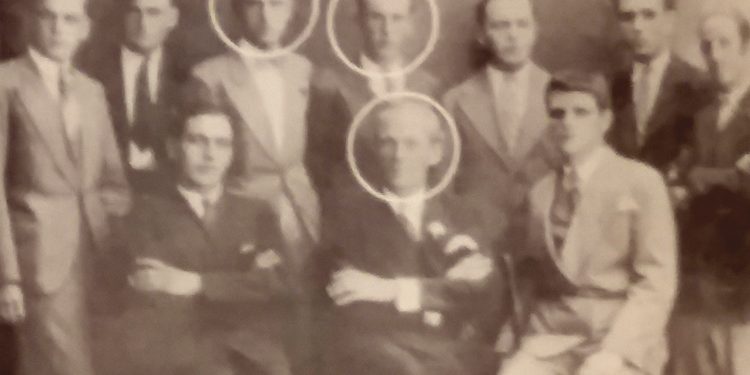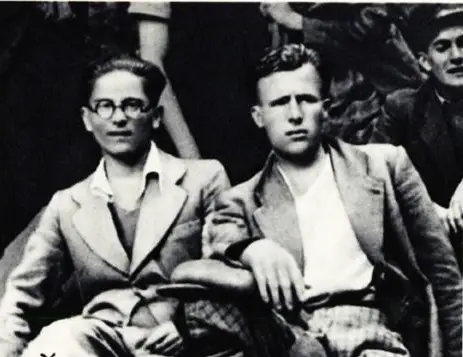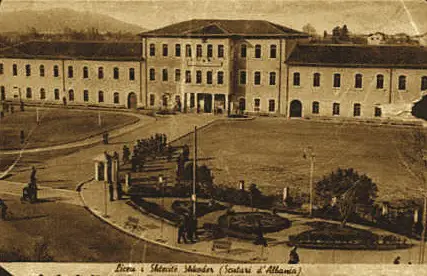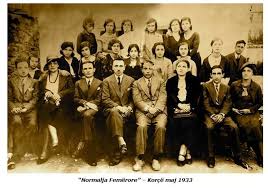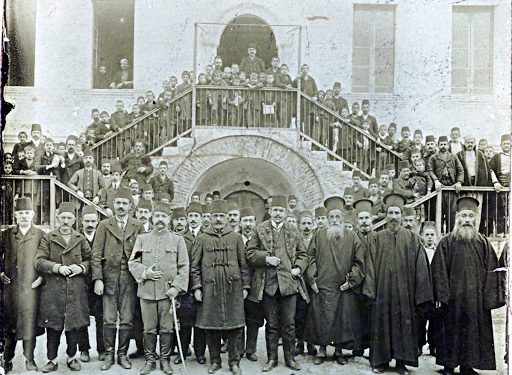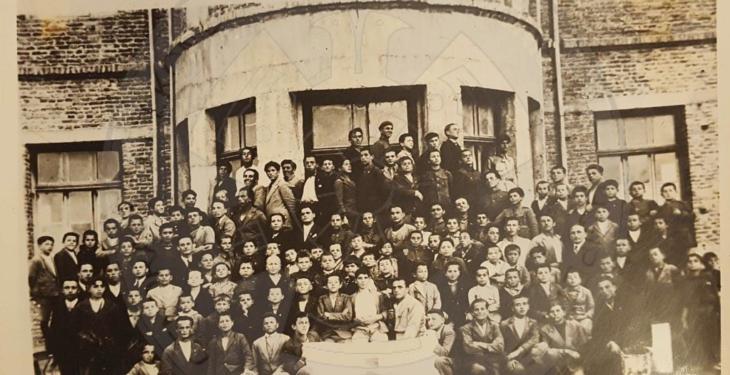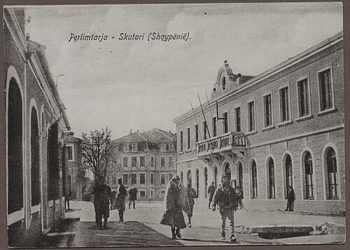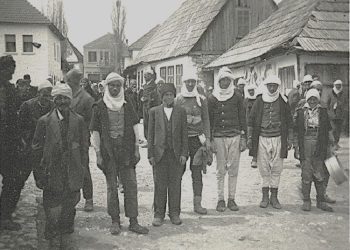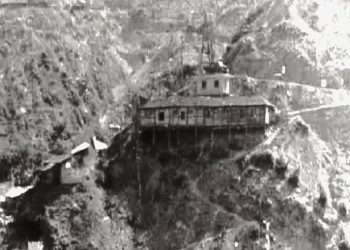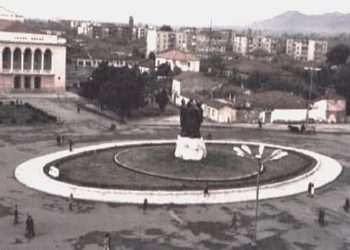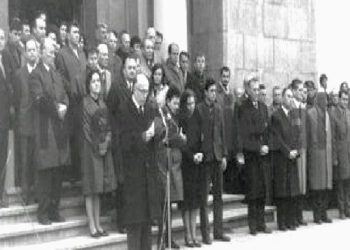Dashnor Kaloçi
Memorie.al publishes the unknown history of the opening of the first state high schools in Albania, which began in 1925 when Prime Minister Ahmet Zogu decreed the opening of the first high school in Tirana, which after 1945 would be named “Qemal Stafa”. where since its creation, some of the most famous names who have led the Albanian state and made a name for themselves in various fields of life, such as art, culture, science, have taught as lecturers or sat on its benches as students , sports, etc., such as: Qamil Bala, Mihal Sherko, Gabriel Meksi, Venjamin Dashi, Safet Butka, Hysni Babameto, Aleksandër Xhuvani, Eqerem Çabej, Aleks Buda, Ahmet Gashi, Sali Çeka, Avni Zajmi, Abdurrahim Buza, Fahri Llagami, Qazim Turdiu, Gjergj Canco, Aqif Selfo, Petraq Pepo, Dhimitër Shuteriqi, Lasgush Poradeci, Mark Gurakuqi, Nonda Bulka, Skënder Luarasi, Arshi Pipa, Vedat Kokona, Anton Mazreku, Minella Karajani, Jorgji Pano, Zekria Rexha, Ibrahim Shabani, Naum Stralla, Zef Zymeri, Kol Shiroka, Lirak Dodbiba , Nexhat Hakiu, Mihal Zallari, Henerik Lacaj, Mustafa Greblleshi, Sherif Delvina, Andrea Kushi, Aleko Tashko, Vangjel Gjikondi, Sotir Prifti, Plumb Çeli. Kadri Baboçi, Maqo Marko, Manol Muçka, Bajram Xhaja, Rudolf Paparisto, Sami Kotherja, Neritan Ceka, Sadete Çuçi, Abdulla Kullazi, Gafur Luga, Lydra Biçoku, Mimoza Idrizi, Gjergj Zaharia, etc.
It was 1925 when the Prime Minister of the Albanian government at that time, Ahmet Zogu, by means of a decree, ordered the opening of the first state high school in the city of Tirana. How many secondary schools were operating in Albania at that time and when were they opened? What is the history of the first state high school that was opened in the Albanian capital and who were its first teachers and principals? What was the first building where the gymnasium of Tirana was located, from the two-story house with three or four rooms near the center of the capital, to the current building of the “Qemal Stafa” school, on Durrës street, near “Zogut te Zi”.
Albanian education, after 1920
For the first time, Albanian education began to be organized with regular programs, immediately after the Lushnja Congress, where the Basic Statute of the Albanian State was drawn up, which also sanctioned the opening of the Ministry of Education, which, as soon as it was created, took place before the great difficulties presented by education in our country, with the many absences in schools, programs and textbooks, as well as the necessary framework of the teaching staff. In order to get out of the anarchy in which the educational system was located, just a few months after the Lushnja Congress, in that city in the summer of 1920, an educational congress was held, which aimed to establish and unify school programs, for primary education up to the fifth grade and the unification of terms in the various subjects that were applied until that time. Following that congress, a Literary Commission composed of three specialized inspectors was created at the Ministry of Education, which was charged with the purpose of drafting and compiling common texts for all Albanian education. After that, Primer for the first grades and Singing for the second, third and fourth grades were compiled and published. In the drafting of these texts, the decision of the Literary Commission of Shkodra was taken into account, which had sanctioned that the dialect of Elbasan be used as a literary language in the textbooks. At the same time, parallel to this work, the Ministry of Education presented to the government, the necessary educational framework, which disciplined to some extent the school organization and the criteria for awarding scholarships abroad. This law came into effect in the 1921-22 school year. At that time, the number of schools in Albania reached 452 and the number of teachers 647. Likewise, in some cities, city schools were opened, which in some places functioned together with primary classes. A year later, in 1923, the number of schools increased to 511 and that of students to 26,681, taught by 817 teachers.
Opening of secondary schools
After the high school that was opened in the city of Elbasan, otherwise known as “Normalja”, which is the first school of that level that was opened in Albania, the second high school that followed it was the one that opened in the city of Korça, otherwise known as the French High School. After that, in the school year 1921-’22, in the city of Tirana, the American Red Cross that had come to help the newly created Albanian state, opened the Technical School, which was known as the Technical School of the Red Cross of American Youth. After the Technical School of Tirana, a year later, a “State Gymnasium” was opened in the city of Shkodra, and the Lyceum of Korça became a boarding school. After these high schools, in the school year 1923-’24, the Lyceum was opened in the city of Gjirokastra, and a year later, the female “Normalja” was opened in the Lyceum of Korça. The opening of these schools would be followed in 1925-’26 by the opening of the commercial school of Vlora and the gymnasium of Berat.
The creation of the high school of Tirana
Although the first attempts to open the state high school in Tirana were made in the years 1923-’24, for the first time it was possible to become a reality, only in 1925, when the prime minister of the Albanian government at that time, Ahmet Zogu , newly in power, by means of a decree ordered the opening of the first state high school in the Albanian capital. In the attempts that were made to open the first high school in Tirana from 1922, in the press of the time it is said: “The state high school that was opened in the Albanian capital Tirana, has a director, four professors and two teachers, in which they teach 98 students in five classes”. The first building where it was decided to open the state gymnasium of Tirana in the school year 1925-’26, was a two-story private house, with three or four rooms, (which was located near the present-day center of the capital), which the Ministry of Education took rent. The first director of this high school was Qamil Bala. After that building where the state high school of Tirana was located, that school was moved to another building somewhere near “Shallvareve”, to be located in 1934, in the former military barracks “Teuta”, located near “Skënderbeg” square (there where today the Chamber of Commerce is located, at the beginning of Kavaja Street). After the first director Qamil Bala, at the head of the high school of Tirana, the Ministry of Education appointed Mihal Sherko, who had graduated in Philosophy and History (with the degree of Doctor of Sciences) in Odes of the Soviet Union, in 1915 and after graduation, he also completed an advanced pedagogy course in Odesa. After finishing that course, Sherko worked for five years (1916-1921) as a Latin teacher at the College of Odessa. In 1921-’22, he worked at Varna College in Bulgaria, from where he returned to Albania and worked for two years as a teacher of Albanian Literature at the French Lyceum in the city of Korça.
First teacher principals
After Sherko, at the head of that school came Karl Gurakuqi, originally from the city of Shkodra. In addition to Bala, Sherko and Gurakuq, from the creation of that school until 1944 when the war ended, Venjamin Dashi, Safet Butka and Hysni Babameto were at the head of the high school in Tirana. Likewise, a large number of pedagogues have taught in that gymnasium since its creation and continuing during the Monarchy period. Of these, some of the personalities of education, science and Albanian culture are worth mentioning, such as: Aleksandër Xhuvani, Eqerem Çabej, Aleks Buda, Ahmet Gashi, Sali Çeka, Avni Zajmi, Abdurrahim Buza, Fahri Llagami, Qazim Turdiu, Gjergj Canco, Aqif Selfo , Petraq Pepo and Dhimitër Shuteriqi. All these luminaries of Albanian education, among others, have been honored with the title “Teacher of the People” for their contribution. In addition to these personalities, many prominent people have taught at the state high school in Tirana during the years of the Zog Monarchy and the War period, who later made a big name in various fields of Albanian art, culture and science. Among these are the well-known: Lasgush Poradeci, Mark Gurakuqi, Nonda Bulka, Skënder Luarasi, Arshi Pipa, Vedat Kokona, Anton Mazreku, Minella Karajani, Gavril Meksi, Jorgji Pano, Zekria Rexha, Ibrahim Shabani, Naum Stralla, Zef Zymeri, Kol Shiroka , Lirak Dodbiba, Nexhat Hakiu, Mihal Zallari, Henerik Lacaj, Mustafa Greblleshi, Andrea Kushi, etc.
The teachers and high school students who led Albania
In the state gymnasium of Tirana since the last years of the Monarchy period, a large number of students have studied who years later became the main figures who led the Anti-Fascist War. So in the banks of that school, students and teachers were divided into two camps, communists and nationalists, who in fact cooperated openly between them until September 1943. Of the teacher’s students who supported the communist wing and were active in that ideas, included: Ramiz Alia, Manush Alimani, Siri Kodra, Ibrahim Uruçi, Muhamer Spahiu, Naim Frashëri, Qevqeb Kambo, Skënder Begeja, Astrit Leka, etc. Whereas the wing that supported nationalist ideas and sympathized with the “National Front” organization and its head, Mithat Frashëri, included: Ramazan Turdiu, Seit Demneri, Rexhep Spahiu, Arif Peza, Agim Leka, Piro Vila, Mustafa Mëniku, Xhemal Alihmemeti , Halil Balla, etc. Among these students and teachers who sat down to learn there, many of them years later became personalities of political and social life, led to the top of the pyramid of the Albanian state. Thus we can mention former president Ramiz Alia, Prokop Murra, (Minister of Defense) Muhamer Spahiu, (General Secretary of the Council of Ministers) Alqi Kondi, (First Secretary of the Communist Youth of Albania) Jovan Antoni, (Ambassador) Ibrahim Uruçi (Secretary of the Union of Writers and Artists) etc. Also, many students graduated from that school who later became major soldiers and received the rank of general, who led the Albanian army for many years. Near the state high school of Tirana during the years 1939-40, the former head of the Albanian communist state, Enver Hoxha, also taught as an external lecturer for the subject of French.
High school students who were killed in the War
During the period of fascist occupation, the high school building of Tirana was moved from Rruga e Kavaja, to Boulevard “Musolini” (today “Zogu i Parë”), where the Faculty of Natural Sciences is today. In addition to many personalities from different fields who have learned in the banks of the high school in Tirana, a large number of students came out of that school and joined the Anti-Fascist Movement of the Albanian people during the Second World War. Thus, it can be said that the gymnasium of Tirana, at that time, became the first base of the war units, both of the communists and of the nationalists. If we refer to the figures of the history of the Communist Movement in Albania, it can be seen that many partisans graduated from that school, 72 of them were killed in the War, who were declared Martyrs of the Fatherland and 13 of them hold the high title ” Hero of the People”, such as: Qemal Stafa, Vasil Shanto, Manush Alimani, Asim Zeneli, Margarita Tutulani, Ali Demi, Myslym Keta, Nazmi Rushiti, Skënder Çaçi, Shejnaze Juka, Shyqëri Ishmi, Themo Vasi and Alqi Kondi. In the same way, despite the fact that there are no exact figures, a large number of students and teachers came out of that school, who filled the Nationalist Front and Legality factions, where many of them were killed during the War, or were physically eliminated during the period 45 years of the communist regime of Enver Hoxha. After the end of the War, the state high school of Tirana was named “Qemal Stafa”, in honor of its former student who was martyred in the War and is considered a symbol of the Communist Youth and the entire cause of the Albanian communists from the period of the War until Nowadays. Since the time of the War, that gymnasium was tried to be called “Naim Frashëri”, but it was not possible. In 1957, the “Qemal Stafa” gymnasium building was moved near the end of Durrës Street, where it is still located today. From 1944 onwards, Aleko Tashko, Vangjel Gjikondi, Sotir Prifti, Pllumb Çeli have directed that high school. Kadri Baboçi, Maqo Marko, Manol Muçka, Bajram Xhaja, Rudolf Paparisto, Sami Kotherja, Sadete Çuçi, Abdulla Kullazi, Gafur Luga, Lydra Biçoku, Mimoza Idrizi, Gjergj Zaharia, etc.
Personality who brought out “Qemal Stafa”
Since the establishment of that gymnasium, until today, a large number of students have come out of the door of that school, who years later made a great name in various fields of life, such as in art, science, culture, sports etc. Thus prominent personalities of science can be mentioned, such as: Shefqet Ndroqi, Bajram Preza, Besim Daja, Petrit Radovicka, Alfred Uçi, Neritan Ceka, Skënder Shkupi, Adelina Mazreku, etc. Famous names, giants of the stage and the screen have emerged from the field of art, such as: Naim Frashëri, Sandër Prosi, Panajot Kanaçi, Pirro Mani, Vaçe Zela, Robert Ndrenika, Agim Prodani, Kujtim Spahivogli, Enver Birko, and even the youngest. , such as: Ndriçim Xhepa, Gazmend Gjoka, Marjana Kondi, Eranda Libohova, Rovena Dilo, Igli Tare, etc. It is also worth mentioning the former students of this school who became talented painters and sculptors such as: Sali Shijaku, Janaq Paço, Abdurrahim Buza, Xenofon Dilo, Shaban Hadëri, Nexhmedin Zajmi, Fatmir Haxhiu, Zef Bumçi, Maks Velo, etc. Of those students who became well-known writers, we can mention Dalan Shapllo, Muzafer Xhaxhiu, Jakov Xoxe, Gjergj Zheji, Sherif Delvina, Zini Sako, Diana Çuli, Teodor Keko, Mustafa Greblleshi, and even the youngest such as: Mira Meksi etc. Likewise, a large number of well-known sportsmen have graduated from this high school who have made a big name not only in our country, but have honored the colors of Albania and in international activities, such as: Skënder Begeja, Besim Fagu, Masar Aga, Enver Maçi, Edra Alibegaj, Klodeta Gjini, Petrit Dibra, Sulejman Demollari, Kostandin Shkurti, Roland Avrami, etc.
Commemoration of the 75th anniversary of the gymnasium
Exactly 20 years ago, to commemorate the 75th anniversary of the opening of the state high school of Tirana, which today bears the name “Qemal Stafa”, by the directorate of that school headed by Gjergj Zaharia, for three days from December 18 to 20 of the year 2000, jubilee ceremonies were organized with numerous cultural, artistic and sports activities. A large number of former students of this school were invited to these ceremonies, who brought many memories and impressions from the years they had spent there. A very valuable work to highlight the history of this school since its creation was also done by the talented teacher, Shpresa Bejo, who for years has collected a very rich archival and photographic material related to the history of the first high school of the Albanian capital. For years, Mr. Hasan Stafa, the grandson of the “People’s Hero”, Qemal Stafa, (son of Alajdin Stafa, Qemal’s brother and former student at that high school), whose name bears that school, one of the most popular in Albania. /Memorie. al





